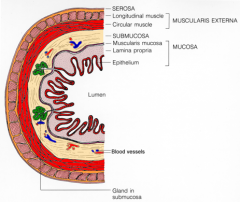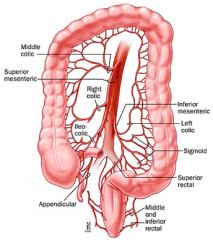![]()
![]()
![]()
Use LEFT and RIGHT arrow keys to navigate between flashcards;
Use UP and DOWN arrow keys to flip the card;
H to show hint;
A reads text to speech;
45 Cards in this Set
- Front
- Back
|
Layers of colon wall
|

|
|
|
Colon secretes _____ and reabsorbs _____.
|
K
Na and water |
|
|
Blood supply of colon
|

|
|
|
Marginal artery of Drummond
|
Collateral flow between SMA and IMA`
|
|
|
Arc of Riolan
|
Short direct connections between SMA and IMA
|
|
|
Blood supply of rectum
|
Superior rectal (IMA)
Middle rectal (Internal iliac) Inferior rectal (Internal pudendal from internal iliac) |
|
|
Watershed areas of colon
|
Splenic flexure (Griffith's point) - SMA and IMA
Rectum (Sudak's point) - superior and middle rectal a. |
|
|
Landmarks from anal verge
|
Anal canal: 0 - 5 cm
Rectum: 5 - 15 cm Rectosigmoid jx: 15 - 18 cm |
|
|
Anterior fascia
|
Denonvillier's (rectovesicular/rectovaginal)
|
|
|
Posterior fascia
|
Waldeyer's fascia (rectosacral)
|
|
|
Main nutrient of colonocytes
|
SCFA
|
|
|
Polyps with increased cancer risk:
|
- > 2 cm
- sessile - villous |
|
|
Polypectomy adequate if:
|
- 2 mm margins
- well-differentiated - no lymphovascular invasion |
|
|
CRC associated organism
|
Clostridium septicum
|
|
|
CRC main gene mutations
|
P53
APC k-ras DCC |
|
|
Most important prognostic factor in CRC?
|
Nodal status
-#1: Liver spread -#2: Lung spread |
|
|
Worst prognosis with which histologic type of CRC?
|
Mucoepidermoid
|
|
|
Margins needed for CRC
|
2 cm
|
|
|
CRC staging and prognosis
|

Duke's staging:
Stage I: A - B1 Stage II: B2 Stage III: C1 - C2 Stage IV: D |
|
|
Transanal excision of rectal cancer appropriate when?
|
- T1 < 4 cm
- Can get 1 cm negative margins - No neurovascular invasion |
|
|
Neoadjuvant chemo-XRT in which stage of CRC cancer
|
Stage II and III rectal CA
-May shrink rectal tumors and down-staging allowing LAR rather than APR -Decreases local recurrence and increases survival |
|
|
Chemo in CRC
|
FOLFOX
-5-FU -Leucovorin -Oxaliplatin |
|
|
XRT complications
|
Vasculitis
Ulcers Thrombosis Stricture |
|
|
Total colectomy in FAP
|
Age 20
|
|
|
Most common cause of death in FAP following surgery
|
Periampullary duodenal tumors
-Need duodenal endoscopy every 2 years |
|
|
Gardner's syndrome
|
Desmoid tumors
Osteomas CRC (FAP) |
|
|
Turcot's Syndrome
|
Brain tumors
CRC (FAP) |
|
|
Lynch syndrome also known as _____ and associated with mutations in which gene?
|
HNPCC
DNA mismatch repair genes |
|
|
Types of Lynch syndrome
|
Lynch I - CRC
Lynch II - CRC + ovarian, endometrial, bladder, stomach |
|
|
Diagnostic criteria for HNPCC
|
Amsterdam criteria:
3 first degree relatives 2 generations 1 under 50 |
|
|
Sigmoid vs. cecal volvulus
|
Sigmoid: Older patients, 50% can be decompressed with colonoscopy/sigmoid colectomy
Cecal: 20s-30s, 20% can be decompressed, right hemi |
|
|
Extraintestinal manifestations that do not improve with colectomy in UC
|
-PSC
-Ankylosing spondylitis |
|
|
EI manifestations that improve with colectomy in UC
|
-Most ocular problems
-Arthritis -Anemia |
|
|
Ogilvie's treatment
|
If colon > 10 cm, colonoscopic decompression and neostigmine, cecostomy if that fails
|
|
|
Fecally contaminated food/water may contain?
|
Entamoeba histolytica
|
|
|
E. Histolytica infection
|
Primary - colonic, resembles UC with dysentery, 3-4 BM/day, cramping, fever
Secondary - liver Diagnosis - colonoscopy shows ulceration, trophozoites. Anti-amebic antibodies. Treatment - FLAGYL, diiodohydroxyquin |
|
|
Cecal mass, abscess, fistula or induration that is suppurative or granulomatous may be?
|
Actinomyces - see sulfur granules on pathologgy
|
|
|
Treatment of actinomyces
|
Penicillin or tetracycline, abscess drainage
|
|
|
Arteriography detects?
|
Bleeding > 0.5 cc/min
|
|
|
Tagged RBC scan detect?
|
Bleeding > 0.1 cc/min
|
|
|
Angiodysplasia associated with?
|
Aortic stenosis, improves after valve replacement
|
|
|
Pneumatosis intestinalis following chemo
|
Neutropenic typhilitis
|
|
|
Treatment of neutropenic typhilits
|
Antibiotics NOT surgery (unless perforated)
|
|
|
Infection that mimics appendicitis
|
Yersinia
Treat with tetracycline or Bactrim |
|
|
Most common cause of acquired megacolon
|
T. cruzi
Due to nerve destruction |

